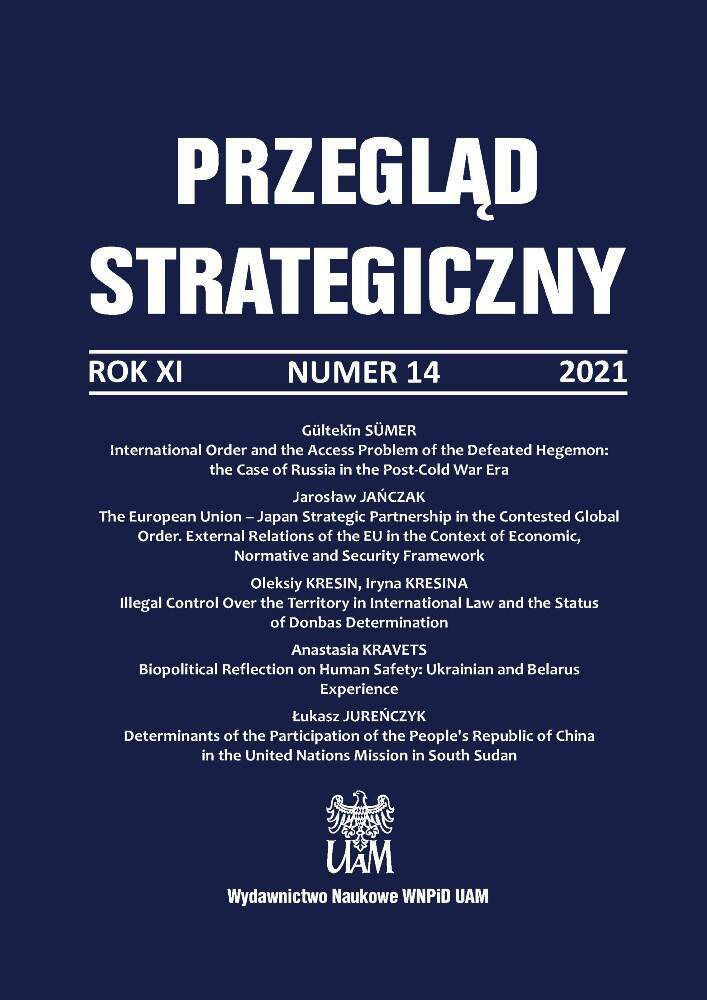Abstrakt
Artykuł analizuje główne siły napędowe rewitalizacji sowieckich narracji ideologicznych w Uzbekistanie i Tadżykistanie. Kluczowym bodźcem do podjęcia badań jest stale rosnąca liczba ataków terrorystycznych, w których zginęły dziesiątki ofiar śmiertelnych w Rosji, popełnio nych przez bojowników pochodzących z Azji Środkowej, a także aresztowania kilkudziesięciu członków różnych organizacji religijnych zakazanych w Uzbekistanie i Tadżykistanie. Hipoteza opiera się na założeniu, że ideologiczna kakofonia wywodząca się z głębokich kontrowersji zawartych w przerobionych sowieckich narracjach ideologicznych jest główną przyczyną problemu. Stosując podejście „path dependence”, wskazuję przede wszystkim na interakcję między gwałtownym wzrostem ekstremizmu religijnego a dezorientacją ideologiczną spowodowaną dezorientacją ideologiczną w regionie trwającą od rozpadu Związku Radzieckiego w 1991 roku, aby odpowiedzieć na główne pytanie badawcze: „Jakie są zewnętrzne implikacje postsowieckich narracji ideologicznych w Uzbekistanie i Tadżykistanie?” Z artykułu wynika również, że post-niepodległościowa polityka tożsamości nie ma na celu budowania nowej idei, ale dyskutowania lub trzymania na dystans tożsamości marginalizowanych w okresie sowieckim. Sowiecka spuścizna stanowi rdzeń tożsamości neoetnicznych wprowadzonych przez byłych przywódców komunistycznych, tylko nieznacznie przerobionych z wysoce selektywnymi i politycznie umotywowanymi dodatkami. Ostre sprzeczności zawarte w tych narracjach, mające na celu zapewnienie celów politycznych, są jednym z czynników napędzających ideologiczną dezorientację, która z kolei działa jak wylęgarnia rekrutacji młodzieży uzbeckiej i tadżyckiej do globalnych sieci terrorystycznych.
Bibliografia
Alshimi M. (2018), Analyze of factors causing radicalization among migrant workers from Central Asia in Russia (in Russian), Rusi Org, https://www.sfcg.org/wp-content/uploads/2018/04/RUSI-report_Central-Asia-Radicalisation_%D0%A0%D0%A3%D0%A1_24042018.pdf.
Akcali P. (1998), Islam as a common bond in Central Asia: Islamic Renaissance Party and the Afghan Mujahidin, „Central Asian Survey”, Vol. 17, No. 2.
Barrett R. (2017), Beyond the caliphate: foreign fighters and the threat of returnees, The Soufan Center, https://thesoufancenter.org/wp-content/uploads/2017/11/Beyond-the-Caliphate-Foreign-Fighters-and-the-Threat-of-Returnees-TSC-Report-October-2017-v3.pdf.
Bennigsen A., Wimbush E. (1979), Muslim national communism in the Soviet Union: a revolutionary strategy for the colonial world, University of Chicago Press, Chicago–London.
Bennigsen A. (1988), Soviet strategy and Islam, Palgrave.
Blakkisrud H., Nozimova S. (2010), History writing and nation building in post-independence Tajikistan, „Nationalities Papers: The Journal of Nationalism and Ethnicity”, Vol. 38, No. 2.
Carlisle D. S. (1986), The Uzbek Power Elite: Politburo and Secretariat (1938-1939), „Central Asian Survey”, Vol. 5, No. 3–4.
Cummings S. (ed.) (2002), Power and change in Central Asia, Routledge, London–New York.
Dagiev D. (2014), Regime transition in Central Asia: stateness, nationalism and political change in Uzbekistan and Tajikistan, Routledge, London–New York.
Deutsche Welle (26.06.2015), Stoit li opasatsya radikalizatsii gasterbayterov v Rossii?, https://asiaplustj.info/ru/news/tajikistan/security/20150626/stoit-li-opasatsya-radikalizatsii-gastarbaiterov-v-rossii.
Epkenhans T. (2017), Islam, Religious Elites, and the State in Post–Civil War Tajikistan, in: Islam, Society, and Politics in Central Asia, (ed.) J. Jones, University of Pittsburgh Press, Pittsburgh.
Gleason G. (1986), Sharaf Rashidov and the dilemmas of national leadership, „Central Asian Survey”, Vol. 5, No. 3–4.
Haugen A. (2003), The establishment of national republics in Soviet Central Asia, Palgrave Macmillan, New York.
Keller S. (2001), To Moscow not Mecca: the Soviet campaign against Islam in Central Asia: 1917–1941, Praeger, Westport–Connecticut–London.
Khalid A. (2007), Islam after communism, Religion and politics in Central Asia, University of Calofornia Press, Berkeley–Los Angeles.
Kudaibergenova D. T. (2014), The Soviet legacy, primordalism and patterns of ideological development since 1991, in: Social and cultural change in Central Asia: the Soviet legacy, (eds.) S. Akyıldız, R. Carlson, Routledge, London–New York.
Laurelle M. (2007), The return of the Aryan myth: Tajikistan in search of a secularized national ideology, “The Nationalities Papers”, Vol. 35, No. 1.
Laurelle M. (2018), The nation narrated: Uzbekistan’s political and cultural nationalism, in: Constructing the Uzbek State: Narratives of the Post-Soviet, (ed.) M. Laurelle, Lexington Books, Lanham MD.
Lemon E. (2015), Daesh and Tajikistan: The regime’s (in)security policy, “RUSI Journal”, Vol. 160, Issue 5.
Lewis D. (2015), Illiberal Spaces: Uzbekistan’s extraterritorial security practices and the spatial politics of contemporary authoritarianism, “Nationalities Papers”, 43, No. 1.
Marat E. (2008), Imagined past, uncertain future: the creation of national ideologies in Kyrgyzstan and Tajikistan, “Problems of post-Communism”, Vol. 55, No. 1.
March A. F. (2002), The use and abuse of history: “National ideology” as transcendental object in Islam Karimov’s “ideology of national independence”, „Central Asian Survey”, Vol. 21, No. 4.
Nozimova S., Epkenhans T. (2019), The transformation of Tajikistan’s religious field: from religious pluralism to authoritarian intertia, „Central Asian Affairs”, Vol. 6, No. 2–3.
Olcott M. B. (1992), Central Asia’s catapult to independence’, “Foreign Affairs”, Vol. 71, No. 3.
Omelicheva M. Y. (2011), Counterterrorism politics in Central Asia, Routledge.
Peyrouse S. (2007), Islam in Central Asia: national specificities and postsoviet globalization, “Religion, State and Society”, Vol. 35, No. 3.
Pierson P. (2000), Increasing returns, path dependence, and the study of politics’, “The American Political Science Review”, Vol. 94, No. 2.
Putin: Nearly half of 20,000 foreign fighters in Syria hails from CIS, Sputnik News Agency, 12 April 2017, https://sputniknews.com/middleeast/201704121052556932-putin-cis-syria-foreign-fighters/ (28 February 2021).
Putin tanks Trump for foiling New Year attacks, BBC News, 29 December 2019, https://www.bbc.com/news/world-europe-50941754 (28 February 2021).
Rashid A. (1994), The resurgence of Central Asia: Islam or nationalism, Oxford University Press, Oxford.
Roche S. (2017), The Family in Central Asia: New Perspectives, Klaus Schwarz Verlag, Berlin.
Roy O. (2000), The new Central Asia. The Creation of Nations, I. B. Tauris Publishers, London–New York.
Russia arrests alleged 22 ISIS agents, Zenger News, 29 July 2020, https://www.zenger.news/2020/07/29/russia-arrests-22-alleged-isis-agents/ (01 March 2021).
Sakiev A. (2020), Guest warriors: The phenomenon of post-soviet fighters in the Syrian conflict, “Journal of Eurasian Studies”, Vol. 11(2): 188–200.
Sewel W. Jr. (1996), Three temporalities: toward an eventful sociology, in: The historic turn in the human sciences, (ed.) Terrance J. McDonald, University of Michigan Press, Ann Arbor.
Slezkine Y. (1994), The USSR as a Communal Apartment, or How a Socialist State Promoted Ethnic Particularism, “Slavic Review”, Vol. 53, No. 2.
Tucker N. (2015), Central Asian involvement in the conflict in Syria and Iraq: drivers and responses, USAID, Management Systems International.
Yemelianova G. (ed.) (2010), Radical Islam in the former Soviet Union, Routledge Publications, London–New York.

